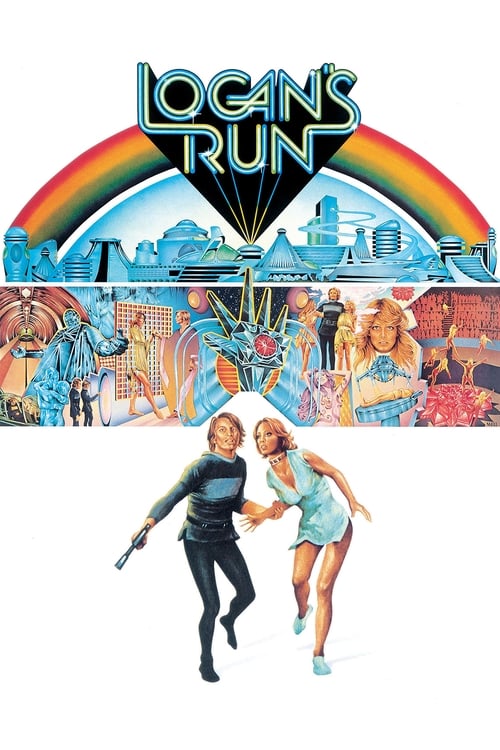Even though Logan’s Run came out in 1976, there’s a distinct feel of 1968 to it. If you want some extra entertainment while watching Logan’s Run (and you may), remind yourself that Star Wars was released eleven months and two days later. There’s a good reason for this, but we’ll get to that in a bit.
This movie is about a utopian future society where life is managed by a computer. To control the population and manage resources, no human lives past the age of thirty. The residents of the City aren’t clear on this point, though. They believe on “Last Day” they are given an opportunity at “Renewal” at the Jellicle Ball “Carousel.” There they float up into the air as though they have had too much Fizzy Lifting Drink. Then they explode, presumably renewed.

Sandman Logan 5 sends a runner off to never-never land.
Logan 5, Michael York, is a “Sandman,” the film’s equivalent of a police officer, whose job it is to track down and execute people who refuse participation in Carousel. The Computer sends Logan on an undercover mission to locate Sanctuary, a mythical place where successful runners live outside of the Computer’s control and die a natural death. He is unwittingly aided in this mission by Jessica 6, Jenny Agutter, a member of the underground railroad to Sanctuary.
At a certain point, Logan 5 is also waited on by a bubble-headed Farrah Fawcett playing Holly 13. I mention this because Fawcett plays heavily enough in some of the marketing material for Logan’s Run that it seems like she’s a central character, not a bit part. Agutter gets a raw deal on the poster, but then again, Agutter was not starring in Charlie’s Angels at the time. Even a contemporaneous article in American Cinematographer calls her a co-star, but she’s barely more than a cameo. I wonder what it must feel like to be the focus of the movie but sidelined in marketing.

I see Agutter once, and Fawcett three times. The illustrator has even replaced Agutter with Fawcett in one of the scenes represented here.
Keeping in mind that the movie is from the mid-seventies, and the special effects in Star Wars have been very-much upgraded in commercially available copies, Logan’s Run looks pretty great. There are a lot of miniatures that are obviously models, but they are intricate and impressively designed. There’s a bizarre sequence towards the end of the movie that features Michael York’s head in six holograms. These were apparently real holograms. Real groundbreaking stuff, totally lost on me forty-five years into the CGI future. The “futuristic” atrium outside of Carousel, which looks like a shopping mall from the time when shopping malls were not wastelands of half-empty food courts and vape shops, is the Dallas World Trade Center. The absolutely gorgeous Fort Worth Water Gardens, which look like a science-fiction set to begin with, serve as a back-door entrance to the domed City.
Despite all of this, I spent the entire run time of the film convinced I watched a movie from the 1960s. Many people of that era viewed science fiction as barely more than children’s fiction. When talking about Barbarella in 1968, director Roger Vadim said, “In science fiction, technology is everything… The characters are so boring---they have no psychology.” Logan’s Run also belongs to that aesthetic. The character development is so flat Logan 5’s epiphany about the City’s true nature barely makes a ripple. At the risk of obsessing about this, someone apparently felt the female characters were entirely interchangeable.

Really, I’m not bitter on Agutter’s behalf. I am sure she can take care of herself.
Logan’s Run has a conservative, moralistic, anti-communist, traditionalist theme and a tone that seems more like a fable than a story. Peter Ustinov quoting extensively from Old Possum’s Book of Classical Cats doesn’t help matters. And yet, Star Wars and Close Encounters of the Third Kind were both released the next year. Alien was released just three years later. Why such a giant leap?
Director Michael Anderson might be somewhat at fault here; his career began in the late 1930s, and he started directing in 1950, mostly adventures and thrillers. But maybe it’s because the movie was intended for release in 1968 but languished in development over script arguments. Whatever the reason, the end result is a movie set in the future, a technological achievement for its present, but firmly rooted in the past.

This is supposed to be some sort of hydro-electric collecting pool for the city instead of an architectural marvel.

